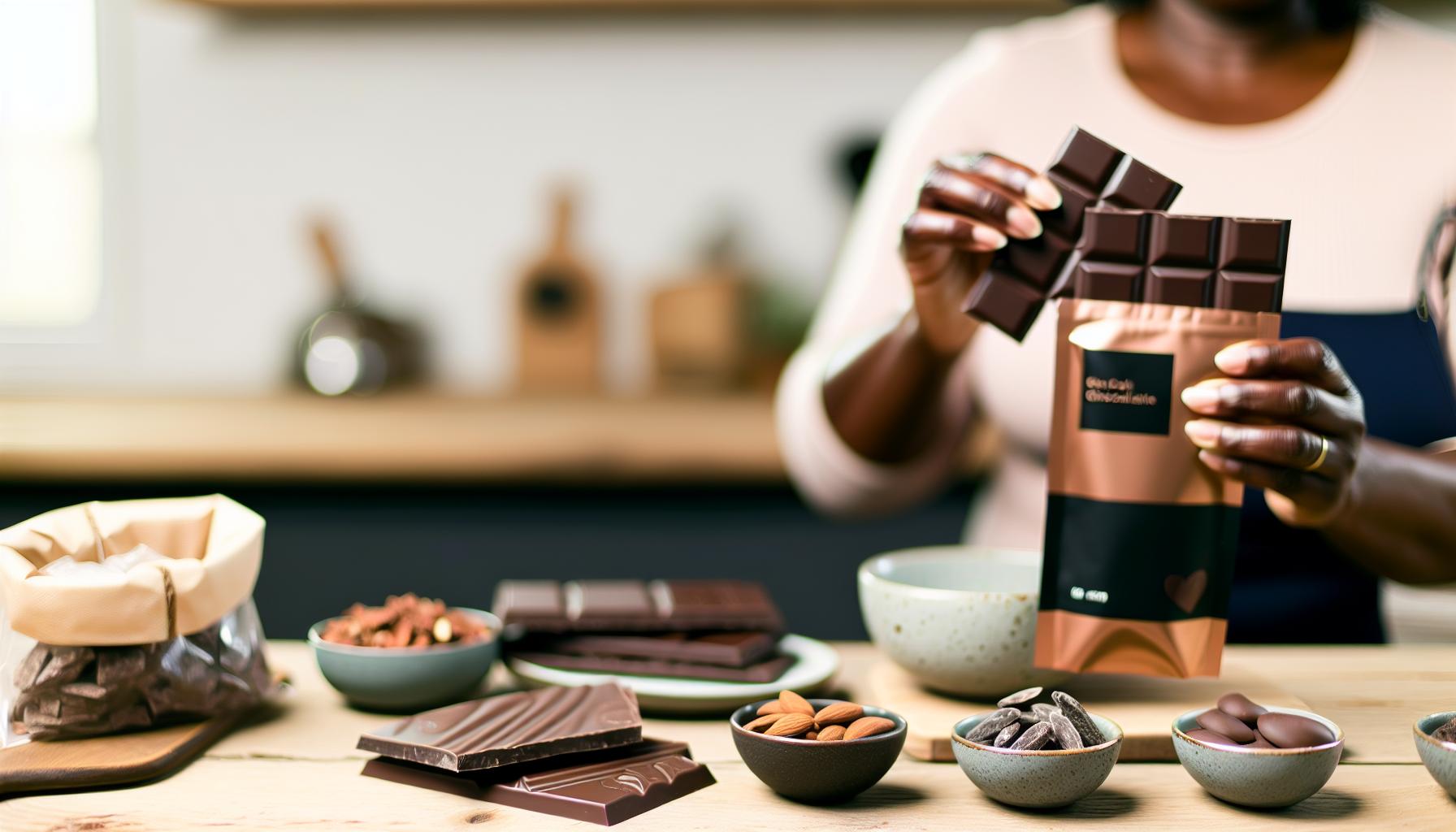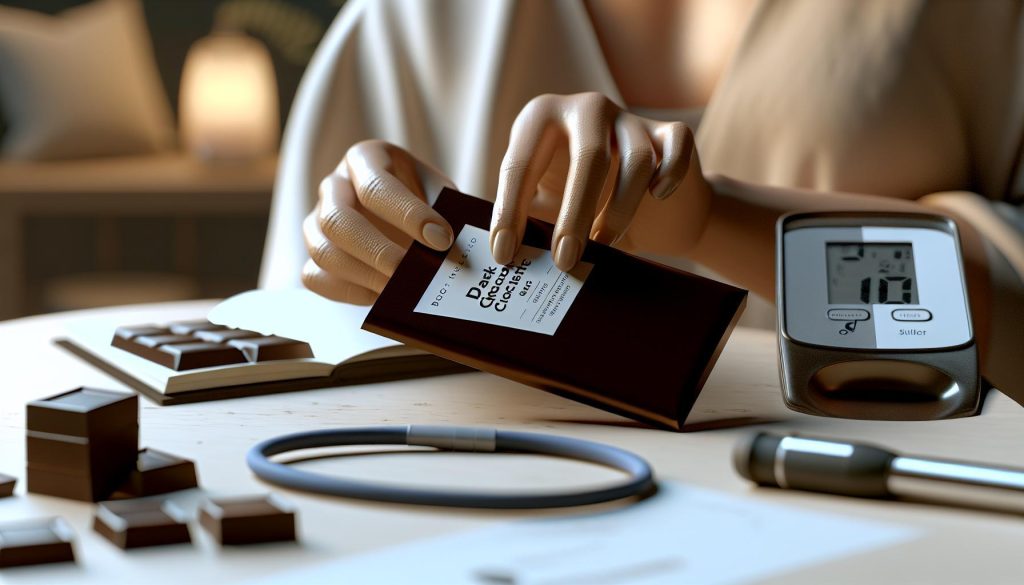When it comes to satisfying your sweet tooth while managing diabetes, finding the right treat can feel daunting. Did you know that dark chocolate, especially varieties with low sugar content, can be a delicious and guilt-free option? With many options available, it’s crucial to focus on those with under 5g of sugar, allowing you to indulge without compromising your health. This guide will explore the best low-sugar dark chocolate choices for diabetics, ensuring that you can enjoy a delightful treat while staying mindful of your dietary needs. Read on to discover delicious options that align with your health goals and make sweet moments possible!
Best Dark Chocolate Options for Diabetics
Indulging in dark chocolate can be a delightful experience, even for those managing diabetes. When selecting dark chocolate options, it’s essential to prioritize products that keep sugar content at bay while delivering rich flavors and health benefits. Dark chocolate with cocoa content of 70% or higher is generally recommended, as it typically contains less sugar and more antioxidants. For diabetics, focusing on chocolates labeled as “low sugar” or “sugar-free” can make a significant difference.
Many brands are now catering specifically to those with dietary restrictions, providing options that boast under 5 grams of sugar per serving. Here are some of the best dark chocolate choices for diabetics that you might consider:
- ChocZero: Known for their zero-sugar products, ChocZero utilizes monk fruit to sweeten their dark chocolate. Their bars often have a cocoa content above 70% and are low in carbs.
- Lily’s Sweets: With an impressive variety of flavors, Lily’s chocolates are sweetened with stevia and consistently contain less than 5 grams of sugar per serving, making them a popular choice.
- Alter Eco: This brand offers organic dark chocolate bars with high cocoa percentages, ensuring minimal sugar content without sacrificing taste.
- Green & Black’s Organic Dark Chocolate: With varieties featuring 70% cocoa or more, this brand provides a richer taste and lower sugar, perfect for a guilt-free treat.
Exploring these brands allows diabetics to enjoy the pleasure of chocolate while being mindful of their sugar intake. Remember to check serving sizes and ingredient lists to ensure the best choices for your health. Additionally, consulting with a healthcare provider or nutritionist can aid in making informed chocolate selections that align with your overall diabetes management plan, ultimately balancing enjoyment and health.
Understanding Sugar Content in Dark Chocolate
Indulging in dark chocolate can serve as a delicious yet strategic choice for those managing diabetes. Understanding the sugar content in dark chocolate is vital to making informed selections. The unique appeal of dark chocolate lies in its rich flavor profiles and potential health benefits, but for diabetics, the challenge is to enjoy it without compromising blood sugar levels. Higher cocoa content, ideally above 70%, typically correlates with lower sugar levels, making these options more favorable.
When examining labels, it’s important to recognize that not all dark chocolates are created equal. Many products boast varying sugar content, and some may even contain hidden sugars under alternative names, such as glucose syrup or sucrose. Opting for chocolates labeled as “low sugar” or “sugar-free” can significantly reduce sugar intake. For example, chocolates sweetened with sugar substitutes like stevia or erythritol often maintain sweetness while drastically lowering sugar content.
Being proactive in reading ingredient lists is key to maintaining a balanced approach to chocolate indulgence. Look for dark chocolate brands that specify the amount of sugar per serving, aiming for products that keep it below 5 grams. This mindfulness not only aids in blood sugar management but also enhances the enjoyment of chocolate by ensuring guilt-free consumption. By staying informed and choosing wisely, diabetics can savor the rich flavors and benefits that dark chocolate offers while aligning with their nutritional goals.
Health Benefits of Dark Chocolate for Diabetics
Indulging in dark chocolate can be a delightful way for individuals managing diabetes to enjoy a treat while potentially reaping health benefits. Research has indicated that consuming high-quality dark chocolate in moderation may have positive effects on health due to its rich content of antioxidants and flavonoids. These compounds can play a beneficial role in heart health, which is particularly important for those with diabetes as they are at an increased risk for cardiovascular issues.
Cardiovascular Health: Dark chocolate, especially varieties containing at least 70% cocoa, is known to enhance heart health by improving circulation and reducing blood pressure. Flavonoids found in dark chocolate help to stimulate the endothelium, the lining of blood vessels, leading to better blood flow and lower risk of blood clots. This is crucial for diabetics, as they often face increased cardiovascular risks.
Blood Sugar Regulation: Interestingly, dark chocolate has a relatively low glycemic index (GI) compared to many other sweets, meaning it has a lesser impact on blood sugar levels. The antioxidants in dark chocolate may also improve insulin sensitivity, enhancing the body’s ability to manage blood sugar. This makes it a more viable option for those looking to incorporate chocolate into their diet without causing significant spikes in their glucose levels.
Brain Health: Regular consumption of dark chocolate might also benefit cognitive function and mood. The flavonoids can help increase blood flow to the brain, potentially improving memory and other cognitive functions. Furthermore, enjoying a small amount of dark chocolate can boost serotonin levels, which can positively impact mood and help combat feelings of anxiety or depression often associated with chronic conditions like diabetes.
To harness these benefits while keeping sugar intake in check, it’s important to select dark chocolate options that have low sugar content-preferably under 5 grams per serving. Look for responsible brands that emphasize low sugar and high cocoa content, ensuring you enjoy a delicious treat that aligns with your health objectives. Remember, while dark chocolate can be part of a balanced diet, moderation is key, and it’s advisable to consult with a healthcare professional regarding your specific dietary choices.
Top Low Sugar Dark Chocolate Brands to Try
Incorporating low sugar dark chocolate into your routine can be a satisfying way for diabetics to indulge without compromising health. Fortunately, there are several brands dedicated to crafting delightful chocolate experiences that are specifically mindful of sugar content. When searching for dark chocolate that fits within a diabetic-friendly lifestyle, it’s essential to consider those low in sugar-ideally under 5 grams per serving.
One standout option is Lily’s Sweets. Their chocolate bars are sweetened with stevia, making them a popular choice among health-conscious consumers. With a variety of flavors, including Salted Caramel and Almond, you can enjoy rich chocolate while maintaining a low sugar intake. Another excellent choice is ChocZero, known for its use of monk fruit as a sweetener, which keeps sugar levels at bay without compromising the chocolate’s flavor. They offer a range of products, including baking chips and dark chocolate bars, catering to various culinary preferences.
For those looking for a clean ingredient profile, Alter Eco makes organic dark chocolate that contains only a few ingredients and is flavored with natural elements like coconut sugar. This brand’s commitment to sustainability and health provides a double benefit-indulging in delicious chocolate while supporting ethical practices. Additionally, Endangered Species Chocolate offers fantastic low sugar or no sugar added selections that are not only tasty but also help raise awareness for endangered animals, creating a sense of purpose with each bite.
When choosing chocolate, always check the label for sugar content and sweeteners used. Understanding product ingredients can turn chocolate shopping into a mindful experience while ensuring you stick to your dietary goals. By selecting from these brands, you can confidently enjoy dark chocolate and its various health benefits without sabotaging your efforts in diabetes management. Remember to savor it in moderation, as part of your balanced diet, and consult with your healthcare provider for any personalized dietary advice.
How to Read Chocolate Labels Effectively
Reading chocolate labels may seem straightforward, but for those managing diabetes, it becomes a crucial skill that ensures enjoyable indulgence without compromising health. A deep understanding of the nutritional facts can empower you to make choices that align with your dietary needs and keep your blood sugar levels stable. The key lies in identifying the right components on the packaging to find low sugar dark chocolate options.
Start by looking closely at the Nutrition Facts Panel. Most brands include key metrics such as total sugars, added sugars, and serving size. For a chocolate to qualify as low sugar, aim for options that contain less than 5 grams of sugar per serving. Pay particular attention to whether those sugars are added or naturally occurring. Notably, ingredients like stevia or monk fruit are preferable sweeteners. These alternatives typically do not cause significant spikes in blood sugar, making them ideal for diabetics.
Understanding the ingredient list is just as important as scrutinizing the nutritional values. Ingredients are listed in descending order by weight, meaning the first few items are what the product contains most. Seek brands that highlight high cocoa content first, followed by natural sweeteners, and minimize or eliminate the inclusion of harmful additives and fillers. Also, steer clear of chocolates that list “sugar” or syrups high on the list, indicating that sweeteners dominate their formula. Choosing chocolates that prioritize wholesome and recognizable ingredients can enhance your overall health while offering an enjoyable treat.
Lastly, consider the cocoa percentage indicated on the packaging. High cocoa percentages (70% and above) typically correlate with richer flavors and less sugar compared to lower percentages. This not only satisfies cravings but also contributes to better health benefits, such as improved heart health and reduced inflammation-key concerns for those managing diabetes.
By approaching chocolate labels with this focused strategy, you ensure that the choices you make are not only delicious but also contribute positively to diabetes management. Consulting with healthcare professionals for personalized advice on dietary choices, especially indulgences like chocolate, can further enhance your confidence in making informed decisions.
The Role of Cocoa Percentage in Diabetes
Dark chocolate’s cocoa percentage plays a significant role in its suitability for individuals managing diabetes. A higher cocoa content, typically around 70% or more, means that the chocolate will generally contain more cocoa solids and less sugar, making it a more diabetes-friendly choice. These higher cocoa percentages not only contribute enhanced flavors but also maximize health benefits, which are vital for those who need to monitor their blood sugar levels.
Rich in antioxidants, dark chocolate with high cocoa content has been linked to improved cardiovascular health, better insulin sensitivity, and potential reductions in inflammation. The flavonoids found in cocoa can improve endothelial function and promote better blood flow, which can be particularly advantageous for people living with diabetes. Moreover, the lower sugar content found in higher cocoa chocolates means fewer spikes in blood glucose levels, providing a satisfying treat without compromising health.
When navigating the chocolate aisle, look for products with at least 70% cocoa to ensure you’re getting the maximum health benefits while keeping sugar intake minimized. Many brands now feature distinct labeling that highlights cocoa content, making it easier for consumers. Remember, though, that moderation is essential. While enjoying dark chocolate is possible, it should remain a small part of a balanced diet. Pairing chocolate with fiber-rich foods or proteins can also help mitigate blood sugar spikes, creating a delightful yet health-conscious snacking experience.
As you consider the inclusion of dark chocolate in your diet, it’s essential to consult with healthcare professionals who can provide personalized recommendations tailored to your specific health needs. This collaborative approach ensures that you can enjoy treats like dark chocolate while effectively managing diabetes and maintaining overall well-being.
Creative Ways to Incorporate Dark Chocolate
Dark chocolate can be a delightful addition to a diabetic-friendly diet, and there are numerous creative ways to incorporate it into your meals and snacks. Beyond merely enjoying a piece straight from the package, its rich flavor and versatile nature can enhance a variety of dishes, making it easier to indulge while keeping sugar levels in check.
One simple yet effective method is to use dark chocolate as a topping. Consider adding dark chocolate shavings or a drizzle of melted chocolate to your favorite yogurt or oatmeal. This will not only add a delectable taste but also increase the dish’s antioxidant content. For those who enjoy fruit, pair slices of apple or pear with a sprinkle of cocoa nibs or dark chocolate chips for a healthy snack that feels indulgent.
Another great way to incorporate dark chocolate is through baking. When making brownies or muffins, substitute a portion of the sugar with cocoa powder or melted dark chocolate, ensuring it meets the low-sugar criteria. Additionally, using dark chocolate in a trail mix with nuts and seeds can provide a satisfying crunch with health benefits, perfect for on-the-go snacking.
Don’t forget about beverages, too! Consider making a chocolate-infused drink by mixing cocoa powder with unsweetened almond milk. Heat it gently, and then stir in a small amount of dark chocolate for an indulgent hot chocolate that’s lower in sugar. You can also create a refreshing smoothie by blending spinach, a tablespoon of dark chocolate, a few berries, and a protein source like Greek yogurt.
Incorporating dark chocolate into your diet doesn’t have to be restrictive. With these creative approaches, you can enjoy a variety of delectable options that keep your sugar levels in mind while still indulging your sweet tooth. Remember to consult with healthcare professionals for tailored guidance, ensuring that these delicious additions fit seamlessly into your diabetes management plan.
Potential Risks of Dark Chocolate for Diabetics
While dark chocolate can be a tasty treat and even beneficial for those with diabetes when chosen carefully, it’s important to be aware of its potential risks. One significant concern is the presence of sugar in many dark chocolate products. Even brands marketed as “low sugar” can contain hidden sweeteners, potentially raising blood glucose levels. Therefore, it’s crucial for diabetics to scrutinize labels thoroughly. Look for options that specifically state they have under 5 grams of sugar per serving and avoid products with high fructose corn syrup or other forms of added sugar.
Another consideration is the fat content. Dark chocolate is rich in fats, particularly saturated fats, which can contribute to weight gain if consumed in excess. Maintaining a healthy weight is vital for managing diabetes, as excess weight can lead to insulin resistance. Moderation is key; even healthy snacks can become unhealthy if consumed in larger quantities than intended. It’s advisable to limit portion sizes and treat dark chocolate as an occasional indulgence rather than a daily staple.
Furthermore, the caffeine content in dark chocolate may pose risks for some individuals. Caffeine can increase heart rate and elevate blood pressure, which may not be suitable for everyone, particularly those with heart-related conditions often seen in diabetic patients. Monitoring how your body reacts to caffeine from dark chocolate is important, as individual tolerance can vary widely.
Incorporating dark chocolate into a diabetic diet can indeed be enjoyable, but it must be approached thoughtfully. Engaging with a healthcare professional can provide personalized advice to navigate these potential risks effectively, ensuring chocolate can remain a delightful part of your life while keeping diabetes management on track.
Comparing Dark Chocolate vs. Milk Chocolate
When it comes to satisfying a sweet tooth, the choice between dark chocolate and milk chocolate is not just about taste; it also involves health implications, especially for individuals managing diabetes. Dark chocolate typically has a higher cocoa content, often ranging from 70% to 90%, compared to milk chocolate, which usually contains only 10% to 50%. This difference in cocoa concentration leads to distinct nutritional profiles and impacts on blood sugar levels.
Cocoa Content and Sugar Levels
Dark chocolate’s high cocoa content means it generally has lower sugar levels than milk chocolate. Most dark chocolates labeled as “low sugar” can have less than 5 grams of sugar per serving, making them a smarter choice for diabetics. In contrast, milk chocolate is often packed with added sugars and can contain up to 20 grams of sugar in a single serving. For those monitoring their carbohydrate intake, switching to dark chocolate can help minimize spikes in blood glucose levels and contribute to better overall glycemic control.
Health Benefits and Nutritional Value
Moreover, dark chocolate carries several health benefits that are particularly advantageous for diabetics. It is rich in flavonoids, which are antioxidants known to improve insulin sensitivity and reduce blood pressure. These components are found in higher concentrations in dark chocolate compared to milk chocolate. Additionally, dark chocolate contains essential minerals like iron, magnesium, and zinc, which play crucial roles in maintaining overall health. On the other hand, milk chocolate often incorporates higher amounts of unhealthy fats and has fewer beneficial nutrients, making it less suitable for diabetic diets.
Considerations for the Best Choices
While dark chocolate offers more health benefits, it’s essential to approach it mindfully. Always check the labels for sugar content and ingredients, and choose varieties with a higher cocoa percentage for the most benefits. Engaging with a healthcare professional can provide tailored advice on how to incorporate chocolate into a balanced diet optimally. Remember, indulging occasionally in dark chocolate can allow you to enjoy sweets without compromising your health or diabetes management plan.
User Reviews: Real Experiences with Low Sugar
Many individuals managing diabetes find joy in exploring low sugar dark chocolate options, as they offer a satisfying treat without compromising their health goals. User experiences reveal a wide range of preferences and tips for making the most out of these delicious choices. Common feedback centers around the importance of flavor, texture, and mindful indulgence, making it crucial for consumers to share their real-life encounters with various brands.
One user shared their delight in discovering a dark chocolate brand boasting less than 5 grams of sugar per serving. They appreciated the rich cocoa flavor and noted how it fulfilled their craving for something sweet without leading to unwanted blood sugar spikes. Many users recommend opting for chocolates with a cocoa percentage of 70% or higher, as these generally provide a more intense taste and may even contribute to better health benefits, such as improved heart health and enhanced insulin sensitivity.
Online communities have become a valuable resource for sharing insights. Users often discuss the importance of reading labels closely, emphasizing the need to look out for hidden sugars and additional ingredients that could impact glycemic control. One user mentioned their strategy of pairing low sugar dark chocolate with nuts for a satisfying snack that provides both healthy fats and proteins, helping to mitigate blood sugar fluctuations.
Ultimately, it’s clear that personal experiences with low sugar dark chocolate can vary widely, depending on individual tastes and dietary needs. Encouraging others to engage with their healthcare professionals when integrating these treats into their diets ensures that every sweet bite aligns with their health goals. Sharing tips, brand recommendations, and personal stories helps create a supportive community focused on enjoying life without compromising health, making the journey of managing diabetes a bit sweeter.
Delicious Recipes Using Low Sugar Dark Chocolate
Cooking with low sugar dark chocolate can be an exciting way to satisfy your sweet tooth without compromising your health. These delicious recipes aim to incorporate dark chocolate elements while keeping sugar content under control, making them excellent options for diabetics. By focusing on simple ingredients and easy-to-follow instructions, anyone can enjoy the rich taste of chocolate while adhering to their dietary needs.
Start your culinary journey with Dark Chocolate Avocado Mousse. This creamy dessert is both satisfying and nutritious. Simply blend ripe avocados, a low sugar dark chocolate bar, unsweetened cocoa powder, a splash of vanilla extract, and a sugar substitute like stevia or erythritol. Chill the mixture in the refrigerator for about 30 minutes before serving. The result is a decadent treat that’s rich in healthy fats and fiber, ensuring that you feel full and content without spiking your blood sugar.
For a quick and easy snack, try Dark Chocolate Almond Clusters. Melt low sugar dark chocolate and stir in a mix of raw almonds and a sprinkle of sea salt. Drop spoonfuls of the mixture onto parchment paper and let them harden in the refrigerator. These clusters not only provide a satisfying crunch but also pack a protein punch, making them a perfect on-the-go snack that can prevent cravings and help maintain steady energy levels.
Another delightful option is Dark Chocolate Covered Strawberries. Simply dip fresh strawberries in melted low sugar dark chocolate and place them on a baking sheet lined with parchment paper to set. These sweet yet tart treats can satisfy your chocolate cravings in a healthy way. They offer a burst of flavor along with antioxidants from both the chocolate and the berries.
Lastly, consider creating a Low Sugar Dark Chocolate Bark. Spread melted low sugar dark chocolate onto a parchment-lined baking dish, sprinkle with your choice of nuts, seeds, and perhaps a few dried fruits with no added sugars, then refrigerate until firm. Once set, break it into pieces for a delicious snack that’s perfect for sharing. This recipe is versatile; you can adjust toppings based on personal preferences or dietary requirements.
Incorporating low sugar dark chocolate into your dietary regime doesn’t need to feel restrictive. By utilizing the rich flavors of cocoa-based products, you can create snacks and desserts that align with your health goals. Always remember to consult with healthcare professionals for personalized advice as you explore delicious chocolate recipes tailored for diabetes management.
Expert Tips for Enjoying Chocolate in Moderation
Discovering how to indulge in dark chocolate while managing diabetes can feel like a balancing act, but it’s entirely achievable with mindful choices and moderation. Research indicates that consuming dark chocolate in controlled amounts may contribute to better heart health and improved insulin sensitivity. This doesn’t mean you have to forgo your favorite treat-rather, it provides an opportunity to enjoy rich flavors without overwhelming your system.
One effective strategy is to choose high-quality dark chocolate varieties that contain less than 5 grams of sugar per serving. Always read the label to ensure you’re picking options lower in sugar, and opt for chocolate with a cocoa percentage of at least 70%. The higher cocoa content means a richer taste, which can help satisfy your cravings with smaller portions. When indulging, aim to keep your portion sizes small; a square or two of dark chocolate can be perfectly satisfying.
In addition to mindful consumption, pair your dark chocolate with snacks that promote blood sugar stability. For example, having a few pieces of dark chocolate alongside a handful of nuts can enhance satiety while minimizing the impact on glucose levels. This combination provides healthy fats and protein, which can buffer the potential glycemic response of the chocolate.
It’s also crucial to stay aware of your overall dietary context. While dark chocolate can be included as a treat, it’s best enjoyed as part of a balanced diet rich in whole foods-including plenty of vegetables, lean proteins, and healthy fats. Finally, listening to your body is key; if you notice fluctuations in your blood sugar levels after enjoying chocolate, consult with a healthcare professional to adjust your strategy. Remember, you’re not depriving yourself-you’re creating a sustainable relationship with food that supports your health goals while allowing for enjoyment.
Faq
Q: What should I look for when choosing dark chocolate for diabetics?
A: When selecting dark chocolate, look for options with at least 70% cocoa and sugar content under 5g per serving. Check ingredient labels for added sugars and artificial sweeteners. This ensures you’re getting both health benefits and lower sugar levels suitable for diabetics.
Q: Can dark chocolate improve insulin sensitivity for diabetics?
A: Yes, studies suggest that dark chocolate can improve insulin sensitivity due to its high flavonoid content. Incorporating moderate amounts of low-sugar dark chocolate in your diet may help manage blood sugar levels effectively.
Q: How can I satisfy my chocolate cravings while managing diabetes?
A: Opt for low-sugar dark chocolate with high cocoa content to satisfy your cravings. Limit portions to one or two squares and pair the chocolate with a source of protein, like nuts, to help stabilize blood sugar levels.
Q: Is sugar-free dark chocolate an option for diabetics?
A: Sugar-free dark chocolate can be a suitable option, but it’s essential to check for sugar alcohols or artificial sweeteners that may affect blood sugar. Moderation is key, as these alternatives can cause gastrointestinal discomfort in some individuals.
Q: What are the potential side effects of dark chocolate for diabetics?
A: While dark chocolate can be beneficial, excess consumption may lead to increased calorie intake and potential weight gain. It’s vital to monitor portions and total carbohydrate intake to prevent blood sugar spikes. Always consult your healthcare provider for personalized advice.
Q: How does cocoa percentage affect dark chocolate suitability for diabetics?
A: Higher cocoa percentages (70% or more) usually mean less sugar and more antioxidants. This makes dark chocolate with a higher cocoa content more suitable for diabetics, as it provides health benefits with lower sugar levels.
Q: Can I include dark chocolate in a diabetic meal plan?
A: Yes, dark chocolate can be included in a diabetic meal plan when consumed in moderation. Aim for low-sugar varieties and monitor portion sizes. Incorporating chocolate as an occasional treat can enhance overall satisfaction without compromising health objectives.
Q: What are some brands of low-sugar dark chocolate for diabetics?
A: Look for brands like Lily’s, ChocZero, and Ghirardelli, which offer low-sugar or sugar-free dark chocolate options. Always check labels for nutrition information to ensure they meet your dietary needs for diabetes management.
In Summary
As you explore the best dark chocolate options for diabetics with less than 5g of sugar, remember that making informed choices can be both satisfying and healthy. This guide highlights delicious alternatives that can satisfy your cravings without compromising your health goals. Don’t miss out! Check our detailed articles on managing diabetes through smart food choices and incorporating sweets into your routine responsibly.
Ready to take the next step? Sign up for our newsletter to receive expert tips and the latest updates on diabetic-friendly products. Your journey toward healthier living doesn’t have to be lonely-share your thoughts below or connect with our community for support and encouragement. Keep exploring, and empower yourself with knowledge today!












